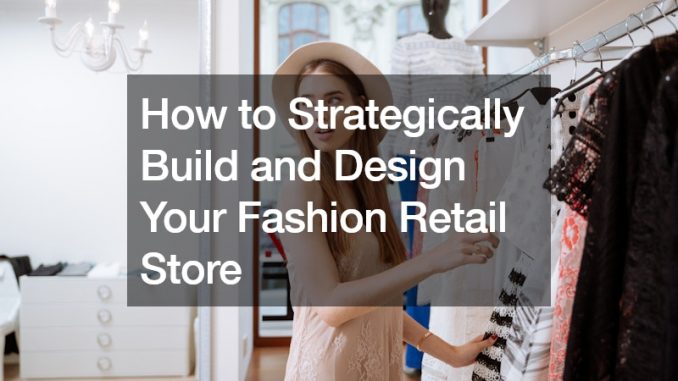
Building and designing a fashion retail store is an endeavor that blends creativity with practicality and aesthetics with functionality. Whether you’re starting from scratch or renovating an existing space, here are essential steps and considerations to ensure your store reflects your brand identity and attracts your target audience.
1. Define Your Vision and Aesthetic
The foundation of any successful retail space is a clear and defined vision. Start by conceptualizing the atmosphere you want your store to convey.
Consider elements like theme, color palette, and overall ambiance. Are you aiming for a modern and minimalist look, or perhaps a cozy and rustic feel? Your aesthetic choices should align closely with your brand identity and resonate with your target demographic.
For instance, if your fashion brand emphasizes femininity and creativity, incorporating soft textures, vibrant colors, and elegant design elements would be key. Think about the customer journey through your store and how each design choice contributes to their experience.
2. Engage Experts for Construction and Design
While you may have a keen eye for fashion, enlisting the expertise of professionals in construction and interior design is crucial. They can navigate building codes, handle raw materials, and manage deadlines effectively, ensuring your vision translates seamlessly into a physical space.
Collaborate closely with architects and contractors to bring your ideas to life while adhering to practical considerations such as structural integrity and spatial efficiency. Their technical knowledge will complement your creative input, resulting in a well-executed design that meets both aesthetic and functional requirements. Meanwhile, a commercial painting contractor ensures that your store’s interior and exterior are finished professionally, making your retail space appealing to customers. This collaborative approach guarantees that every aspect of your fashion retail store—from initial concept to final touches—supports your brand’s identity and provides a welcoming environment for your customers.
3. Incorporate Brand Identity Throughout
Your store should serve as a tangible expression of your brand identity. From signage to interior decor, every element should reflect your brand’s values and personality. Utilize colors, materials, and textures that resonate with your brand’s aesthetic.
For example, if your fashion line emphasizes sustainability, incorporating eco-friendly materials into your store’s design can reinforce your commitment to environmental consciousness. Similarly, integrating brand colors and motifs into furniture, fixtures, and displays helps establish a cohesive and memorable brand experience for customers.
4. Enhance Customer Experience
Besides aesthetics, prioritize enhancing the customer experience within your store. Consider aspects such as lighting, layout, and flow. Natural light, for instance, can create a welcoming atmosphere and highlight your merchandise effectively. Open layouts with clearly defined areas for browsing, fitting rooms, and checkout contribute to a seamless shopping experience.
Personal touches like comfortable seating areas, thoughtful decor, and interactive displays can further engage customers and encourage longer stays in your store. Remember, the goal is to create a space where customers not only shop but also connect with your brand on a deeper level.
5. Balance Industrial and Natural Elements
Incorporating natural elements alongside industrial architecture can strike a harmonious balance in your retail space. Plants, for instance, add a touch of greenery that softens harsh lines and brings a sense of freshness to the environment. Experiment with different plant varieties, textures, and heights to create visual interest and complement your overall design scheme.
Additionally, utilize natural materials such as wood, stone, or bamboo in your decor and furnishings. These materials not only add warmth and authenticity but also resonate with environmentally conscious consumers.
6. Personalize and Customize
Infuse your store with personal touches that reflect your unique brand story and values. Consider incorporating handmade artwork, custom signage, or locally sourced decor items that showcase your personality and craftsmanship. These elements differentiate your store from competitors while also creating a memorable and authentic experience for customers.
Display personal artwork or quotes that inspire and resonate with your brand ethos. Create a welcoming atmosphere in fitting rooms with flattering lighting, comfortable seating, and mirrors adorned with positive affirmations.
7. Continuously Evolve and Adapt
Building and designing a fashion retail store is an ongoing process of evolution and adaptation. Stay attuned to industry trends, customer feedback, and technological advancements that could enhance your store’s appeal and functionality. Regularly refresh your displays, update decor, and explore innovative ways to engage customers both in-store and online.
By continually refining your store’s design and customer experience, you can grow a loyal customer base and establish your brand as a destination for fashion enthusiasts.
Wrapping Up
Building and designing a fashion retail store requires a delicate balance of creativity, practicality, and attention to detail. By defining a clear vision, collaborating with experts, and infusing your brand identity into every aspect of your store, you can create a compelling and immersive retail environment that resonates with customers and strengthens your brand presence in the competitive fashion industry.
.

